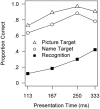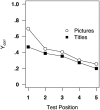Recognition and memory for briefly presented scenes
- PMID: 22371707
- PMCID: PMC3284209
- DOI: 10.3389/fpsyg.2012.00032
Recognition and memory for briefly presented scenes
Abstract
Three times per second, our eyes make a new fixation that generates a new bottom-up analysis in the visual system. How much is extracted from each glimpse? For how long and in what form is that information remembered? To answer these questions, investigators have mimicked the effect of continual shifts of fixation by using rapid serial visual presentation of sequences of unrelated pictures. Experiments in which viewers detect specified target pictures show that detection on the basis of meaning is possible at presentation durations as brief as 13 ms, suggesting that understanding may be based on feedforward processing, without feedback. In contrast, memory for what was just seen is poor unless the viewer has about 500 ms to think about the scene: the scene does not need to remain in view. Initial memory loss after brief presentations occurs over several seconds, suggesting that at least some of the information from the previous few fixations persists long enough to support a coherent representation of the current environment. In contrast to marked memory loss shortly after brief presentations, memory for pictures viewed for 1 s or more is excellent. Although some specific visual information persists, the form and content of the perceptual and memory representations of pictures over time indicate that conceptual information is extracted early and determines most of what remains in longer-term memory.
Keywords: detection; feedforward processing; masking; picture memory; picture perception; rapid serial visual presentation; search.
Figures






Similar articles
-
Recognition memory for briefly presented pictures: the time course of rapid forgetting.J Exp Psychol Hum Percept Perform. 2002 Oct;28(5):1163-75. doi: 10.1037//0096-1523.28.5.1163. J Exp Psychol Hum Percept Perform. 2002. PMID: 12421062 Clinical Trial.
-
Short-term conceptual memory for pictures.J Exp Psychol Hum Learn. 1976 Sep;2(5):509-22. J Exp Psychol Hum Learn. 1976. PMID: 1003124
-
Ultrafast scene detection and recognition with limited visual information.Vis cogn. 2016;24(1):2-14. doi: 10.1080/13506285.2016.1170745. Epub 2016 Jul 8. Vis cogn. 2016. PMID: 28255263 Free PMC article.
-
Conceptual masking: the effects of subsequent visual events on memory for pictures.J Exp Psychol Learn Mem Cogn. 1984 Jan;10(1):115-25. doi: 10.1037//0278-7393.10.1.115. J Exp Psychol Learn Mem Cogn. 1984. PMID: 6242731
-
Presentation rate and the representation of briefly glimpsed pictures in memory.J Exp Psychol Hum Learn. 1980 Jan;6(1):1-12. J Exp Psychol Hum Learn. 1980. PMID: 7373241
Cited by
-
Coherent natural scene structure facilitates the extraction of task-relevant object information in visual cortex.Neuroimage. 2021 Oct 15;240:118365. doi: 10.1016/j.neuroimage.2021.118365. Epub 2021 Jul 4. Neuroimage. 2021. PMID: 34233220 Free PMC article.
-
Memorability shapes perceived time (and vice versa).Nat Hum Behav. 2024 Jul;8(7):1296-1308. doi: 10.1038/s41562-024-01863-2. Epub 2024 Apr 22. Nat Hum Behav. 2024. PMID: 38649460
-
Drawings reveal changes in object memory, but not spatial memory, across time.bioRxiv [Preprint]. 2024 Jan 29:2024.01.26.577281. doi: 10.1101/2024.01.26.577281. bioRxiv. 2024. Update in: Cognition. 2025 Jan;254:105988. doi: 10.1016/j.cognition.2024.105988. PMID: 38352427 Free PMC article. Updated. Preprint.
-
How much can we differentiate at a brief glance: revealing the truer limit in conscious contents through the massive report paradigm (MRP).R Soc Open Sci. 2022 May 24;9(5):210394. doi: 10.1098/rsos.210394. eCollection 2022 May. R Soc Open Sci. 2022. PMID: 35619998 Free PMC article.
-
All-or-none face categorization in the human brain.Neuroimage. 2020 Jun;213:116685. doi: 10.1016/j.neuroimage.2020.116685. Epub 2020 Feb 28. Neuroimage. 2020. PMID: 32119982 Free PMC article.
References
-
- Breitmeyer B. G., Ogmen H. (2006). Visual Masking: Time Slices through Conscious and Unconscious Vision, 2nd Edn New York: Oxford University Press
-
- Chelazzi L., Duncan J., Miller E. K., Desimone R. (1998). Responses of neurons in inferior temporal cortex during memory-guided visual search. J. Neurophysiol. 80, 2918–2940 - PubMed
Grants and funding
LinkOut - more resources
Full Text Sources

